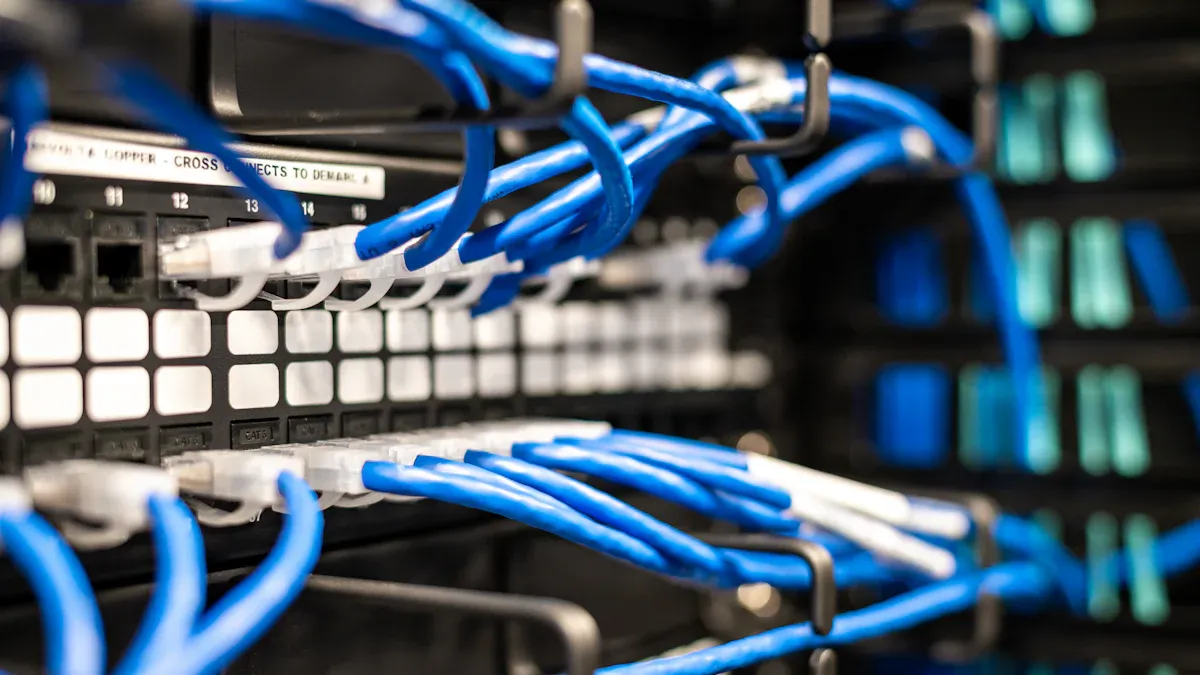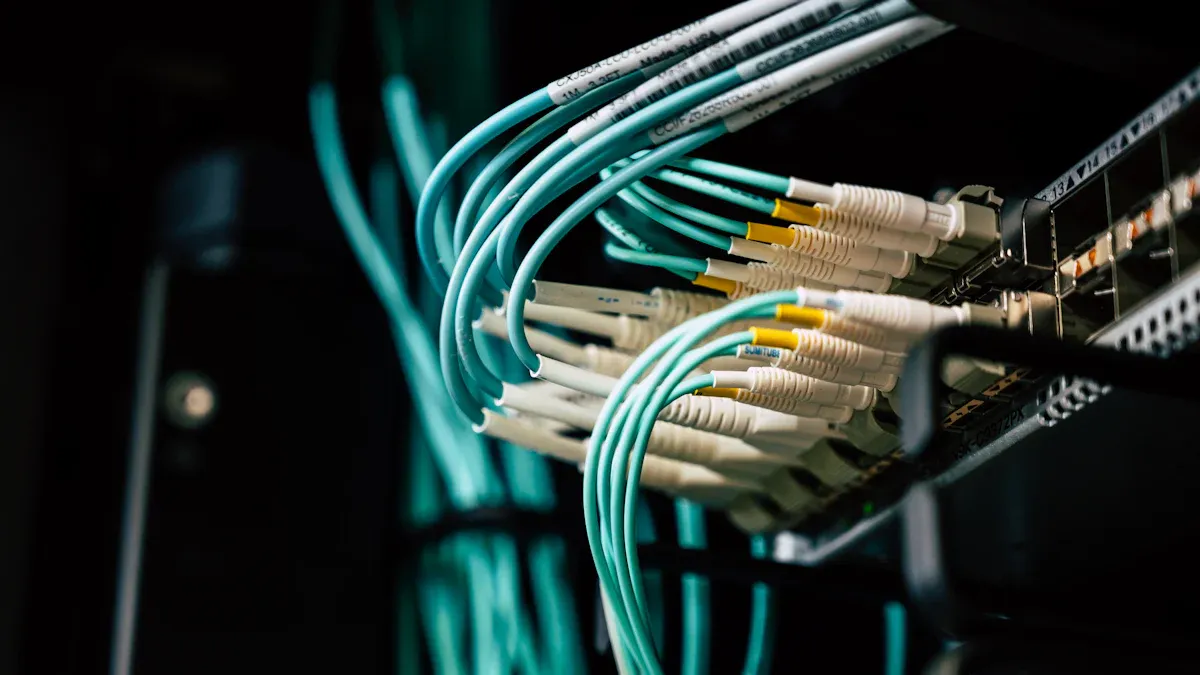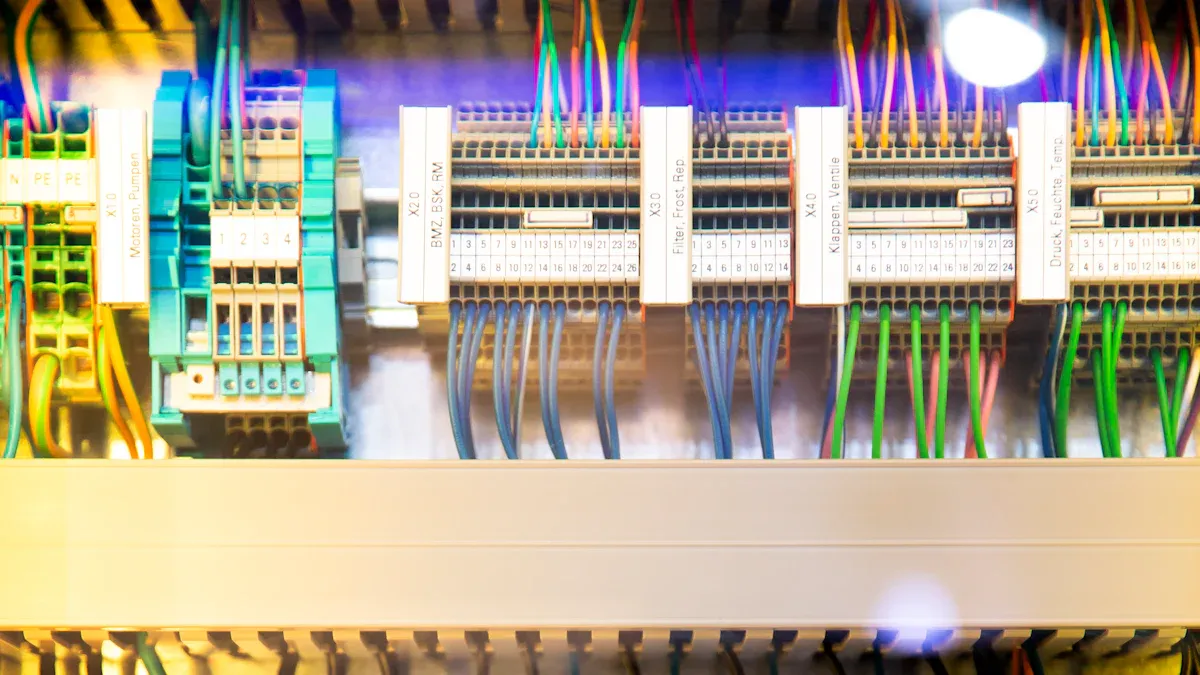How to Choose Communication Protocols for Telecom Cabinet Power Controllers? Modbus/RS485/SNMP Adaptation Scenarios & Compatibility Pitfalls

You face many choices when selecting a communication protocol for a Telecom Cabinet Power Controller. Compatibility with your existing devices often determines what works best. Modbus, RS485, and SNMP each play a unique role in telecom environments. Reliable operation depends on how well your protocol matches your system. You must watch for adaptation scenarios and avoid compatibility pitfalls.
Key Takeaways
Choose a communication protocol that fits your existing telecom infrastructure to ensure smooth integration and avoid costly issues.
Plan for future growth by selecting protocols that support many devices and offer scalable, efficient communication.
Consider environmental factors like temperature, humidity, and interference to maintain reliable operation in harsh telecom cabinet conditions.
Use open standard protocols like Modbus and SNMP to enable vendor independence and easier upgrades.
Avoid compatibility problems by checking device settings, protocol versions, and wiring carefully before integration.
Protocol Selection
Infrastructure Compatibility
When you select a communication protocol for a Telecom Cabinet Power Controller, you must first consider how well it fits with your existing infrastructure. Many telecom sites still use legacy systems that rely on serial communication. Modbus RTU over RS485 often works best in these environments because it supports long-distance transmission and connects multiple devices on a single bus. This protocol remains popular in older telecom setups due to its simplicity and strong noise immunity. In contrast, SNMP requires an IP-based network. If your site uses modern Ethernet infrastructure, SNMP can offer centralized management and broad device compatibility. However, it may not work with legacy serial-based systems.
You should also look for protocols that support interoperability and vendor independence. Open standards like Modbus and SNMP allow you to mix devices from different manufacturers. This flexibility helps you avoid vendor lock-in and makes future upgrades easier. Many manufacturers design their products to support standard protocols such as MODBUS over RS485, which ensures that your Telecom Cabinet Power Controller can integrate smoothly with other equipment.
Tip: Always check if your existing devices and management systems support the protocol you plan to use. This step can save you time and prevent costly integration issues.
Scalability Needs
Scalability is another key factor when choosing a protocol. You need to think about how your network might grow in the future. Modbus networks, for example, can support up to 247 devices per server, but this limit may not be enough for large deployments. The single master architecture of Modbus can also create bottlenecks and single points of failure. RS485, which serves as the physical layer for Modbus, shares these limitations. Serial communication speeds are much slower than modern Ethernet, which can affect performance as your network expands.
SNMP, on the other hand, supports scalable remote monitoring and management. It works well in large networks with many devices. Ethernet-based protocols also offer high bandwidth and can handle many devices at once. The table below compares how different protocols manage increasing numbers of connected devices:
Protocol | Scalability Features | Device Addressing & Management | Bandwidth & Communication Efficiency | Additional Notes |
|---|---|---|---|---|
Ethernet | High bandwidth, supports many devices | Uses switches and repeaters for segmentation | Handles many devices simultaneously | Supports wired, optical, and wireless media |
RS485 | Up to 32 drivers/receivers per segment | Half/full duplex, error checking | Up to 10 Mbps on short distances | Suitable for long distances and multiple nodes |
Modbus | Up to 247 clients per server | Addressed messages, function codes | Uses RS485 or Ethernet variants | Scalable with dedicated servers for monitoring |
SNMP | Scalable remote monitoring | Centralized management | Depends on IP network | Well-suited for large, modern telecom networks |
When you plan for future expansion, choose a protocol that can grow with your needs. Avoid protocols that limit the number of devices or slow down as your network gets larger.
Environmental Factors
Environmental conditions in telecom cabinets can affect protocol performance and reliability. High temperatures can cause equipment to overheat, while humidity can lead to corrosion or static electricity. Water leaks, smoke, and unauthorized access also pose risks. These factors can damage hardware and disrupt communication.
Protocols like Modbus and RS485 are often chosen for their ability to operate reliably in harsh environments. For example, RS485 MODBUS RTU temperature and humidity sensors help you monitor conditions inside outdoor telecom cabinets. These sensors detect overheating, humidity changes, and other risks early, allowing you to take action before equipment fails.
You should also protect your communication lines from electromagnetic interference (EMI). Shielded cables and proper grounding help maintain signal integrity, which is critical for reliable protocol operation. Regular monitoring and maintenance of environmental sensors ensure that your Telecom Cabinet Power Controller continues to function as expected.
Common environmental factors to monitor:
Humidity
Water presence
Door status
Smoke
By considering these environmental factors, you can choose a protocol that supports stable and reliable operation, even in challenging conditions.
Protocol Overview

Modbus Basics
Modbus is a communication protocol you often find in industrial and telecom environments. It uses a master-slave architecture, where one device (the master) controls the communication with multiple slave devices. Modbus RTU usually runs over RS-485 serial lines, making it a good choice for real-time data exchange in battery management and power control systems. You can also use Modbus TCP, which works over Ethernet networks and supports modern IP-based communication.
Key features of Modbus:
Simple binary protocol for efficient data transfer
Supports both serial (RTU) and Ethernet (TCP) communication
Not designed for direct human interaction; you need specialized software to read data
Protocol Variant | Communication Medium | Use Case |
|---|---|---|
Modbus RTU | RS-485, RS-232 | Real-time control over serial connections |
Modbus TCP | Ethernet (TCP/IP) | Integration with modern IP networks |
RS485 Basics
RS-485 is a physical layer standard that lets you connect many devices on a single bus using two or four wires. You often use RS-485 as the backbone for Modbus RTU networks. This standard is known for its noise immunity and ability to support long-distance communication, up to 1200 meters.
Advantages | Disadvantages |
|---|---|
Robust noise immunity | Limited data speed |
Long-distance support | Complex configuration |
Multi-device capability | Limited device count per bus |
Cost-effective | No built-in redundancy |
You benefit from RS-485 when you need reliable, low-power communication in harsh environments. However, you must plan for wiring complexity and device addressing.
SNMP Basics
SNMP (Simple Network Management Protocol) is a protocol you use for network management and remote monitoring. It operates over Ethernet and uses a manager-agent model. SNMP enables you to collect data from sensors and devices inside telecom cabinets, such as power status and breaker trips.
SNMP allows remote monitoring of power conditions.
It sends real-time alerts and notifications to your network management system.
You can track trends and identify root causes of power issues.
SNMP reduces the need for site visits by providing remote visibility.
It integrates easily with existing network management tools.
Ethernet-Based Protocols
Ethernet-based protocols, such as Modbus TCP and SNMP, use IP networking for communication. You get high bandwidth and low latency, which are important for real-time control in telecom cabinets. Modern Ethernet switches support features like precise time synchronization and redundancy, ensuring reliable operation.
Note: Ethernet protocols require network infrastructure and may involve IT security considerations, such as static IP addressing and access control.
You can achieve bandwidths from 10 Gb/s to 100 Gb/s for short connections, making Ethernet suitable for large-scale, high-speed telecom applications. These protocols support remote monitoring and efficient power management, especially in 5G networks.
Adaptation Scenarios
Modbus in Telecom Cabinet Power Controller
You often see Modbus used in telecom cabinet power controller systems for real-time monitoring and control. What are the most common adaptation scenarios?
Multi-protocol edge computing gateways support Modbus to connect legacy systems and process data in real time.
Temperature and voltage sensors use Modbus to detect thermal hazards in telecom equipment and batteries.
Modular sensor solutions compatible with Modbus allow you to monitor broadband and distributed IT sites remotely and upgrade easily.
Solar-powered gateways with NB-IoT connectivity use Modbus for off-grid telecom sites, ensuring energy efficiency and real-time data transmission.
Modbus-enabled sensors fit into advanced automation and predictive maintenance frameworks, helping you reduce downtime and support 5G deployments.
You can monitor HVAC units, diesel generators, and battery strings using Modbus, which gives you real-time alerts and supports proactive maintenance.
RS485 Integration
RS485 serves as a backbone for multi-device communication in telecom cabinet environments. You can connect many devices, such as sensors and power controllers, over long distances. The following table shows typical use cases and benefits:
Protocol | Typical Use Case | Benefit |
|---|---|---|
RS232 | Simple point-to-point links | Easy setup, reliable |
RS485 | Multi-device communication | Long distances, supports many devices |
SNMP | Network management integration | Real-time remote monitoring |
You may face challenges like limited cabinet space, cable management complexity, and the need for protocol compatibility. Cabinet Management Systems often use RS485 (Modbus RTU) to enable remote access control and real-time monitoring, which helps you manage power distribution units and connected equipment efficiently.
SNMP Adaptation
You can adapt SNMP in telecom cabinet power controller environments by following best practices:
Use secure SNMP versions, such as SNMPv3, for encrypted and authenticated communication.
Integrate SNMP with industrial protocols like Modbus and MQTT for comprehensive monitoring.
Implement alarm handling and environmental monitoring to detect issues quickly.
Enable advanced notifications to alert you about critical events.
Use remote access, data logging, and diagnostics to support unattended sites.
Protocol Gateways
Protocol gateways play a key role in connecting different protocols. Devices like the InfraSensing SensorGateway support Modbus TCP, Modbus RTU over RS485, and SNMP v2/v3 at the same time. These gateways act as translators, allowing your telecom cabinet power controller to communicate with network management, building management, and industrial control systems. Features such as SNMP traps, email alerts, and web-based configuration make integration and management easier. Industrial protocol gateways from companies like Advantech and Phoenix Contact also provide multi-protocol support, ensuring seamless data exchange and interoperability across diverse telecom environments.
Compatibility Pitfalls

Device Mismatches
You may encounter device mismatches when integrating Modbus, RS485, and SNMP in your telecom cabinet power controller network. These mismatches often result from differences in hardware, firmware, or physical wiring quality. What are the most common issues you should watch for?
Communication errors can persist even when you use proper termination and shielding. Cable routing near power cables often causes noise interference.
Shield grounding works best when you use a robust clamp on the ground bus bar, not just at connectors.
Disorganized wiring and connecting multiple devices on the same bus can lead to intermittent faults. Isolating devices one by one helps you identify the problematic unit.
High-frequency noise from nearby Variable Frequency Drives (VFDs) can induce voltage spikes. You can reduce interference by using VFD-rated cables, shielding, and ferrite cores on RS485 lines.
Mismatched baud rates and parity settings often cause CRC errors and message corruption.
Improper placement of termination resistors or incorrect dip-switch settings can lead to signal reflections and communication faults.
Grounding issues and noise interference may cause unstable communication. Isolators and proper shielding help mitigate these problems.
Device transmitter timing problems on RS485 half-duplex networks can result in corrupted messages if transmitters do not switch to high impedance correctly.
Device address conflicts on Modbus networks can cause multiple devices to fault at the same time.
Tip: You can troubleshoot device mismatches by adjusting baud rates, parity, and termination resistor configuration. Adding isolators, tuning transmission delays, and improving cable shielding and routing also help resolve communication issues.
Protocol Conflicts
Protocol conflicts arise when devices use incompatible versions or settings. What should you look out for in your telecom cabinet power controller system?
Devices may support different protocol versions, such as Modbus RTU versus Modbus TCP, or SNMP v1 versus SNMP v3. These differences can prevent successful communication.
Some devices use proprietary extensions or custom registers, which may not work with standard protocol implementations.
Physical layer incompatibilities, such as RS485 versus CAN, can block communication if you connect devices with different electrical standards.
Baud rate, parity, and stop bit settings must match across all devices. Any mismatch can cause data corruption or loss.
Addressing schemes differ between protocols. Modbus uses device addresses, while SNMP relies on IP addresses and object identifiers. Mixing these can lead to confusion and integration failures.
Conflict Type | What Happens | How to Avoid |
|---|---|---|
Protocol version | Devices fail to communicate | Match versions across devices |
Physical layer | No signal or corrupted data | Use compatible hardware |
Addressing scheme | Devices respond incorrectly | Standardize addressing |
Custom extensions | Data not recognized | Use open standards |
Note: Always verify protocol versions and physical layer compatibility before connecting new devices. Standardizing settings and using open protocols reduces the risk of conflicts.
Integration Issues
Integration issues can disrupt the operation of your telecom cabinet power controller network. What problems might you face during integration?
Firmware mismatches between devices can cause unpredictable behavior or prevent communication.
Incomplete or outdated documentation makes it hard to configure devices correctly.
Some devices require manual configuration of dip switches, jumpers, or software settings. Missing these steps can block communication.
Environmental factors, such as temperature and humidity, may affect signal integrity and device reliability.
Network management systems may not recognize all device types, especially if you use custom or legacy equipment.
Physical space constraints in telecom cabinets can complicate wiring and device placement.
You can avoid integration issues by following these steps:
Review all device manuals and documentation before installation.
Test each device individually before connecting it to the network.
Use protocol gateways to bridge incompatible devices and translate data formats.
Monitor environmental conditions and maintain proper cable management.
Update firmware and software regularly to ensure compatibility.
🛠️ Troubleshooting Tip: If you experience communication faults, isolate devices one at a time, check wiring and grounding, and verify all protocol settings. Using protocol gateways and isolators can help resolve persistent integration problems.
You can maintain a reliable telecom cabinet power controller network by understanding what compatibility pitfalls exist and what steps you can take to avoid them.
When you choose a communication protocol for your Telecom Cabinet Power Controller, you need to match your system’s needs with protocol capabilities. You should evaluate your infrastructure and plan for future scalability. Modular design, open standards, and remote monitoring help you adapt to new technologies and maintain reliable operation. Use this checklist to avoid compatibility pitfalls:
1. Check scalability for large device networks and future expansion. 2. Ensure low latency for real-time control and monitoring. 3. Confirm wide area coverage for diverse deployment locations. 4. Select standardized protocols for seamless integration. 5. Maintain backward compatibility with legacy systems. 6. Enable remote updates and monitoring for easy maintenance. 7. Document all configurations for long-term support.
Tip: A careful review of your network and future needs helps you choose the right protocol and avoid costly mistakes.
FAQ
What is the main difference between Modbus and SNMP?
Modbus works best for direct device control and monitoring in industrial settings. SNMP focuses on network management and remote monitoring. You use Modbus for real-time data exchange. You use SNMP for centralized alerts and status updates.
What should you check before integrating a new device into your telecom cabinet network?
You should check protocol compatibility, supported versions, and physical connection types. Review device manuals for configuration steps. Test the device on your network before full integration.
What problems can occur if you mix RS485 and Ethernet devices?
Mixing RS485 and Ethernet devices without a gateway causes communication failures. RS485 uses serial signals. Ethernet uses IP packets. You need a protocol gateway to connect them.
What are protocol gateways used for in telecom cabinet power controllers?
Protocol gateways translate data between different communication protocols. You use them to connect devices that speak Modbus, RS485, or SNMP. Gateways help you achieve seamless integration and data exchange.
What environmental factors can affect protocol performance in telecom cabinets?
High temperature, humidity, water leaks, and electromagnetic interference can disrupt communication. You should monitor these factors with sensors. Proper shielding and grounding help maintain reliable protocol performance.
See Also
Complete Instructions For Wiring And Selecting Telecom Cables
Exploring The Function Of Outdoor Cabinets In Telecom Systems
A Clear Overview Of Telecom Cabinet Applications And Benefits
Steps To Guarantee Stable Power For Telecom Cabinets
Tips For Selecting The Ideal Mount For Outdoor Telecom Cabinets
CALL US DIRECTLY
86-13752765943
3A-8, SHUIWAN 1979 SQUARE (PHASE II), NO.111, TAIZI ROAD,SHUIWAN COMMUNITY, ZHAOSHANG STREET, NANSHAN DISTRICT, SHENZHEN, GUANGDONG, CHINA

